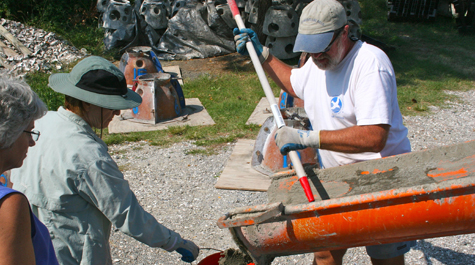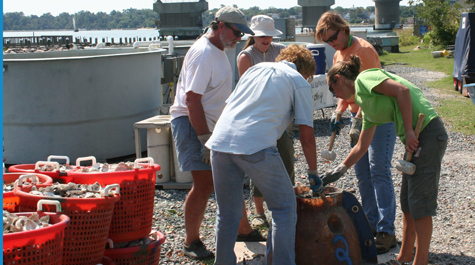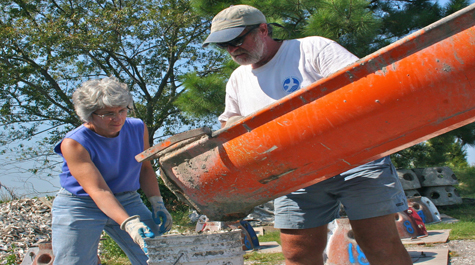VIMS alumnus a leader in oyster restoration, shellfish farming
Tommy Leggett has never lived more than two miles from Chesapeake Bay, so it is no wonder he has such a passion for what lies within the nation’s largest estuary.
At the tender age of 12, the Norfolk native decided that he wanted to be a marine biologist. Fast-forward 30 years later and the VIMS alumnus is a leader in the fields of oyster restoration and shellfish farming.
A 1980 graduate of the Master’s program at VIMS, Leggett now serves as the Virginia Oyster Restoration and Fisheries Scientist for the Chesapeake Bay Foundation. At CBF he focuses on reversing the long-term decline in the Bay’s oyster stocks, while working to inform the public of the role these shellfish can play in restoring the Bay’s health.
Each year, Leggett and work partner Jackie Shanon hold four to six reef-ball construction events on VIMS’ Gloucester Point campus, where he encourages volunteers to help produce alternative oyster-setting substrate for oyster restoration. The reef balls—molded from marine-safe cement to mimic a natural reef—are later placed in the water so that oyster larvae, or “spat”, can attach and start creating a valuable habitat.
“I want to engage citizens in meaningful restoration projects like the reef ball events that will help to restore the Bay,” says Leggett. His most recent event—a three-day affair in late September—was a huge success. “We had about 15 volunteers per day and ended up producing 50 reef balls,” he says.
Leggett says VIMS is the best location for the reef-ball events because of the Institute’s prime location at the mouth of the York River—also the epicenter of oyster disease for the Bay.
“If you’re going to work in oyster restoration you have to confront disease head on,” he says. “If we’re going to solve the current problems that are going on in the Bay we need to hit the nail on the head and that is what we’re doing by holding the reef-ball construction events at VIMS.”
Chesapeake Bay’s oyster population has been depleted to dangerously low levels—a serious issue that Leggett says can be improved with the right people on board. “It’s very difficult to restore a keystone species once it has dwindled to an all-time low, but it’s possible with the help of citizens, stakeholders, and restoration partners,” he says. “Oysters can be restored and sustainably fished with the right approach.”
Since the reef-ball program began in 2010, Leggett and his volunteer crews have created nearly 500 reef balls and used them to create artificial oyster reefs in the Piankatank and Lafayette rivers. He has also conducted restoration projects with state partners in most of the Bay’s major tributaries. Many of these locations are now the site of healthy oyster reefs, which not only produce natural spawn to further increase the oyster population, but also provide important habitat for fish, blue crabs, and other marine life.
In addition to his position at CBF, Leggett runs his own shellfish farming business—aptly called Chessie Seafood and Aquafarms—where he harvests upwards of 100,000 oysters a year for local restaurants. “I like to carve my living out of the Bay,” he says. “Working on the Bay has always come naturally to me and the thought of making a living out of it has always intrigued me.”
Leggett says his predecessors in the oyster aquaculture business taught him a lot through their knowledge and motivation and helped him realize that this is something he is good at and that he loves to do. “I’ve evolved and grown with the industry, and I’m going to keep on plugging along.”
After earning his Master’s degree, Leggett spent 1 year in the Ph.D. program at VIMS before realizing his true love was being on the water. He spent the following years learning how to become a commercial fisherman—a career that he pursued for nearly 20 years. “As a waterman I taught myself how to crab, fish, and oyster by just watching others, listening, and ultimately learning the trade.”
In 1998, Leggett received a job offer from a fellow waterman who was working at CBF at the time. He accepted, and worked as an environmental educator for 2 years before transitioning into oyster restoration.
“I love how my job allows me to be out on the water while still getting to interact with other scientists, especially the ones at VIMS,” he says. “It’s nice having all of that expertise in your backyard.”
Leggett says the time he spent as a student at VIMS helped prepare him for his various career endeavors since his graduation. “Obtaining an interdisciplinary degree in marine science and having the opportunity to work with some of the most respected scientists in the world helped point me in the direction of my true calling—being out on the Bay.”
He is not alone in his endeavors. “Oysters seem to be the poster child of the Bay,” he says. “There is just something about oysters that gets people excited about wanting to help, preserve, and restore the Bay.”


















